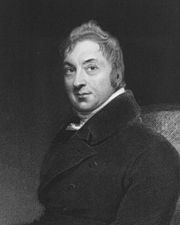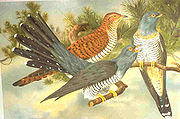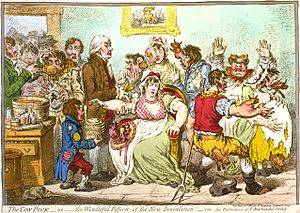
Edward Jenner
Background to the schools Wikipedia
This Wikipedia selection is available offline from SOS Children for distribution in the developing world. All children available for child sponsorship from SOS Children are looked after in a family home by the charity. Read more...
| Edward Jenner | |
|---|---|
 Edward in the prime of his studies |
|
| Born | May 17, 1749 Berkeley, Gloucestershire |
| Died | 26 January 1823 (aged 73) Berkeley, Gloucestershire |
| Nationality | |
| Alma mater | St George's, University of London |
| Doctoral advisor | John Hunter |
| Known for | smallpox vaccine |
Edward Jenner, FRS, ( May 17 1749 – January 26 1823) was an English scientist who studied his natural surroundings in Berkeley, Gloucestershire, England. He is famous as the first doctor to introduce and study the smallpox vaccine, although Benjamin Jesty, a farmer, earlier had vaccinated with cowpox to induce immunity to smallpox. It is believed that Jenner discovered it independently.
Early life
Jenner trained in Chipping Sodbury, Gloucestershire as an apprentice to Dr. Ludlow, a surgeon, for eight years from the age of 14. In 1770 Jenner went up to London to study surgery and anatomy under the surgeon John Hunter and others at St George's, University of London. Hunter was a noted experimentalist, and later a fellow of the Royal Society.
William Osler records that Jenner was a student to whom Hunter repeated William Harvey's advice, very famous in medical circles (and characteristically Enlightenment), "Don't think, try". Jenner therefore was early noticed by men famous for advancing the practice and institutions of medicine. Hunter remained in correspondence with him over natural history and proposed him for the Royal Society. Returning to his native countryside, by 1773 he became a successful general practitioner and surgeon, practicing in purpose-built premises at Berkeley.
Jenner and others formed a medical society in Rodborough, Gloucestershire, meeting to read papers on medical subjects and dine together. Jenner contributed papers on angina pectoris, ophthalmia and valvular disease of the heart and commented on cowpox. He also belonged to a similar society which met in Alveston, near Bristol.
He was elected Fellow of the Royal Society in 1788, following a careful study combining observation, experiment and dissection into a description of the previously misunderstood life of the cuckoo in the nest.
Jenner's description of the newly-hatched cuckoo pushing its host's eggs and fledglings from the nest was confirmed in the 20th century when photography became feasible. Having observed the behaviour, he demonstrated an anatomical adaptation for it—the baby cuckoo has a depression in its back which is not present after 12 days of life, in which it cups eggs and other chicks to push them out of the nest. It had been assumed that the adult bird did this, but the adult does not remain in the area for sufficiently long. His findings were published in the Philosophical Transactions of the Royal Society in 1787.
He married Catherine Kingscote (died 1815 from tuberculosis) in March 1788 having met her when balloons were hot science, and he and other Fellows were experimenting with them. His trial balloon descended into Kingscote Park, owned by Anthony Kingscote, Catherine being one of his three daughters.
In 1792, he obtained his M.D. from the University of St Andrews.
Smallpox
Around this time smallpox was greatly feared, as one in three of those who contracted the disease died, and those who survived were commonly badly disfigured. Voltaire, a few years later, recorded that 60% of people caught smallpox, with 20% of the population dying of it. In the years following 1770 there were at least six people in England and Germany (Sevel, Jensen, Jesty 1774, Rendall, Plett 1791) who had successfully tested the possibility of using the cowpox vaccine as an immunisation for smallpox in humans. For example, Dorset farmer, Benjamin Jesty, had successfully induced immunity in his wife and two children with cowpox during a smallpox epidemic in 1774, but it was not until Jenner's work some twenty years later that the procedure became widely understood. Indeed it is generally believed that Jenner was unaware of Jesty's success and arrived at his conclusions independently.
| Jenner's Initial Theory |
| In fact he thought the initial source of infection was a disease of horses, called "the grease", and that this was transferred to cows by farmworkers, transformed, and then manifested as cowpox. From that point on he was correct, the complication probably arose from coincidence. |
Noting the common observation that milkmaids did not generally get smallpox, Jenner theorized that the pus in the blisters which milkmaids received from cowpox (a disease similar to smallpox, but much less virulent) protected the milkmaids from smallpox. He may have had the advantage of hearing stories of Benjamin Jesty and perhaps others deliberately arranging cowpox infection of their families and of a reduced risk in those families.
On May 14, 1796, Jenner tested his theory by inoculating James Phipps, a young boy of 8 years old, with material from the cowpox blisters of the hand of Sarah Nelmes, a milkmaid who had caught cowpox from a cow called Blossom. Phipps was the 17th case described in Jenner's first paper on vaccination.
Jenner inoculated Phipps with cowpox pus in both arms on one day, by scraping the pus from Nelmes' blisters onto a piece of wood then transferring this to Phipps' arms. This produced a fever and some uneasiness but no great illness. Later, he injected Phipps with variolous material, which would have been the routine attempt to produce immunity at that time. No disease followed. Jenner reported that later the boy was again challenged with variolacious material and again showed no sign of infection.
|
Known: that smallpox was more dangerous than variolation and cowpox less dangerous than variolation. |
| The hypothesis tested: That infection with cowpox would give immunity to smallpox. |
|
The test: If variolation failed to produce an infection, Phipps was shown to be immune to smallpox. |
|
The consequence: Immunity to smallpox could be induced much more safely. |
He continued his research and reported it to the Royal Society, who did not publish the initial report. After improvement and further work, he published a report of twenty-three cases. Some of his conclusions were correct, and some erroneous—modern microbiological and microscopic methods would make this easier to repeat. The medical establishment, as cautious then as now, considered his findings for some time before accepting them. Eventually vaccination was accepted, and in 1840 the British government banned variolation and provided vaccination free of charge. (See Vaccination acts)
Jenner's continuing work on vaccination prevented his continuing his ordinary medical practice. He was supported by his colleagues and the King in petitioning Parliament and was granted £10,000 for his work on vaccination. In 1806 he was granted another £20,000 for his continuing work.
In 1803 in London he became involved with the Jennerian Institution, a society concerned with promoting vaccination to eradicate smallpox. In 1808, with government aid, this society became the National Vaccine Establishment. Jenner became a member of the Medical and Chirurgical Society on its foundation in 1805, and subsequently presented to them a number of papers. This is now the Royal Society of Medicine.
Returning to London in 1811 he observed a significant number of cases of smallpox after vaccination occurring. He found that in these cases the severity of the illness was notably diminished by the previous vaccination. In 1821 he was appointed Physician Extraordinary to King George IV, a considerable national honour, and was made Mayor of Berkeley and Justice of the Peace. He continued his interests in natural history. In 1823, the last year of his life, he presented his Observations on the Migration of Birds to the Royal Society.
He was found in a state of apoplexy on 25 January 1823, with his right side paralysed. He never rallied, and died of what was apparently a stroke (he had suffered a previous stroke) on 26 January 1823, aged 73. He was survived by one son and one daughter, his elder son having died of tuberculosis at the age of 21.
Legacy
In 1980, the World Health Organization declared smallpox an eradicated disease. This was the result of coordinated public health efforts by many people, but vaccination was an essential component. Although it was declared eradicated, some samples still remain in laboratories in Centers for Disease Control and Prevention (CDC) in Atlanta, Georgia in the United States, and State Research Centre of Virology and Biotechnology VECTOR in Koltsovo, Novosibirsk Oblast, Russia.
Monuments
- Jenner's house is now a small museum housing among other things the horns of the cow Blossom. It lies in the Gloucestershire village of Berkeley.
- The word vaccination comes from the Latin vaccinia, cowpox, from vacca, cow.
- Jenner was buried in the chancel of the parish church of Berkeley.
- A statue, by Robert William Sievier, was erected in the nave of Gloucester Cathedral.
- A statue was erected in Trafalgar Square, later moved to Kensington Gardens.
- Near the small Gloucestershire village of Uley, Downham Hill is locally known as 'Smallpox Hill', with a possible connection to Jenner's local work with the disease.
- St George's, University of London has a wing named after him as well as a bust of him.
- A small grouping of villages in Somerset County, Pennsylvania, United States, were named in honour of Jenner by early 19th century English settlers, including what are now the towns of Jenners, Jenner Township, Jenner Crossroads and Jennerstown, Pennsylvania. The towns collectively have a population of about 6000.
Publications
- 1798 An Inquiry Into the Causes and Effects of the Variolæ Vaccinæ
- 1799 Further Observations on the Variolœ Vaccinœ
- 1800 A Continuation of Facts and Observations relative to the Variolœ Vaccinœ 40pgs
- 1801 The Origin of the Vaccine Inoculation 12pgs



